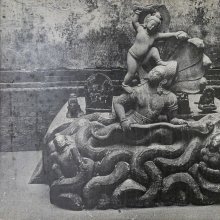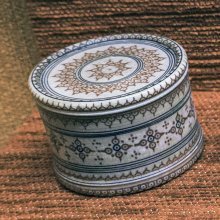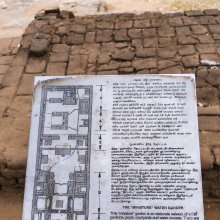Damana, Damanā, Damaṇa: 25 definitions
Introduction:
Damana means something in Buddhism, Pali, Hinduism, Sanskrit, the history of ancient India, Marathi, Jainism, Prakrit, Hindi, biology. If you want to know the exact meaning, history, etymology or English translation of this term then check out the descriptions on this page. Add your comment or reference to a book if you want to contribute to this summary article.
Images (photo gallery)
In Hinduism
Purana and Itihasa (epic history)
Source: archive.org: Puranic Encyclopedia1) Damana (दमन).—A brother of Damayantī. In Mahābhārata, Vana Parva, Chapter 53, Stanza 8 it is mentioned that King Bhīma had a daughter named Damayantī, and three sons named Dama, Dānta and Damana.
2) Damana (दमन).—A hermit. Bhīma the King of Vidarbha pleased this hermit, who blessed the King and said that he would get children. Accordingly the king got Damayantī as his daughter and Dama, Dānta and Damana as his sons. (Mahābhārata Vana Parva, Chapter 53).
3) Damana (दमन).—The son of the King Paurava. Dhṛṣṭadyumna killed Damana in the battle of Bhārata. (Mahābhārata Bhīṣma Parva, Chapter 61, Stanza 20).
4) Damana (दमन).—A son of Bharadvāja. After the investiture with the Brahma string (upanayana) Damana started on a travel. On the way near Amarakaṇṭaka he met with the hermit Garga who talked to him about the glory of Kāśi. Damana who was a seeker of spiritual knowledge, stopped his travel and sat down to do penance and thus leaving his body he attained heaven. (Skanda Purāṇa, Chapter 2, 4, 74).
Source: archive.org: Shiva Purana - English TranslationDamana (दमन) refers to “(proper) suppression”, according to the Śivapurāṇa 2.3.35 (“The story of Padmā and Pippalāda”).—Accordingly, Dharma (in the guise of a king) said to Padmā (wife of sage Pippalāda): “O mother, know me as Dharma elderly and venerable to men of wisdom and preceptors. O chaste lady, I always consider other’s wives as mothers. It was to know your innermost feelings that I approached you. I knew your mind, still I was urged by fate. Only proper suppression (damana), not the contrary, is carried out by you. Chastisement of those who go astray from the right path is carried out by Śiva Himself. [...]”.
Source: Cologne Digital Sanskrit Dictionaries: The Purana Index1a) Damana (दमन).—A son of Vasudeva and Rohiṇi.*
- * Brahmāṇḍa-purāṇa III. 71. 165; Matsya-purāṇa 46. 12. Vāyu-purāṇa 96. 163.
1b) A commander to aid Viṣanga, killed by Kāmesvarī.*
- * Brahmāṇḍa-purāṇa IV. 25. 30, 46, 94.
1c) A son of Angirasa.*
- * Matsya-purāṇa 196. 2.
1d) The avatār of the Lord in the third Dvāpara; had four sons, Viśoka, Vikeśa, etc.*
- * Vāyu-purāṇa 23. 123.
1e) A Ṛtvik at Brahmā's sacrifice.*
- * Vāyu-purāṇa 106. 36.

The Purana (पुराण, purāṇas) refers to Sanskrit literature preserving ancient India’s vast cultural history, including historical legends, religious ceremonies, various arts and sciences. The eighteen mahapuranas total over 400,000 shlokas (metrical couplets) and date to at least several centuries BCE.
Shaktism (Shakta philosophy)
Source: Google Books: Manthanabhairavatantram1) Damanā (दमना) refers to one of the maids (cellakā) associated with Pūrṇagiri, one of the sacred seats (pīṭha), according to the Manthānabhairavatantra, a vast sprawling work that belongs to a corpus of Tantric texts concerned with the worship of the goddess Kubjikā.—Nine of the twelve female servants (three in each of the first four seats), are low-caste women who we find, in other contexts, embody the Mothers (mātṛkā). The maids (cellakā) [i.e., Damanā] are Yoginīs and the servants their male counterparts. These replace the spiritual ‘sons’ and ‘daughters’ the goddess generates and the guardians she appoints in the sacred seats listed in the ‘Kubjikāmatatantra’.
2) Damana (दमन) refers to “having overcome (the impurity of Kali—the Age of Strife)”, according to the Manthānabhairavatantra, a vast sprawling work that belongs to a corpus of Tantric texts concerned with the worship of the goddess Kubjikā.—Accordingly, “The goddess Matsyodarī is Tārā, the (energy) Śāntyatītā who impels the awakened. Mīnanātha, who has overcome the impurity of the Age of Strife (kalimala-damana) is (the Siddha) Sādākhya in the sacred seat of the Moon (i.e. Candrapura). He is the hero who lays hold of the Yoni which is the (supreme) plane of all the universe by means of (his) insights into many (forms of) knowledge. I always bow to him who reveals Kula by means of the various lineages (of initiates)”.

Shakta (शाक्त, śākta) or Shaktism (śāktism) represents a tradition of Hinduism where the Goddess (Devi) is revered and worshipped. Shakta literature includes a range of scriptures, including various Agamas and Tantras, although its roots may be traced back to the Vedas.
Vaishnavism (Vaishava dharma)
Source: Prabhupada Books: Sri Caitanya CaritamrtaDamana (दमन) refers to “cutting down” (rogues and demons), according to the Śrī Caitanya Caritāmṛta 2.20.246 (“The Science of the Absolute Truth”).—(Cf. Śaktyāveśa).—The śaktyāveśa-avatāras are categorized into (1) forms of divine absorption (bhagavad-āveśa), such as Kapiladeva or ṛṣabhadeva, and (2) divinely empowered forms (śaktyāveśa), of whom seven are foremost: [i.e., (7) Paraśurāma, specifically empowered to cut down rogues and demons (duṣṭa-damana-śakti), [...]”.

Vaishnava (वैष्णव, vaiṣṇava) or vaishnavism (vaiṣṇavism) represents a tradition of Hinduism worshipping Vishnu as the supreme Lord. Similar to the Shaktism and Shaivism traditions, Vaishnavism also developed as an individual movement, famous for its exposition of the dashavatara (‘ten avatars of Vishnu’).
In Buddhism
Mahayana (major branch of Buddhism)
Source: WikiPedia: Mahayana BuddhismDamana (दमन) or “taming” refers to one of the “nine mental abidings” (i.e., ‘nine stages of training the mind’) connected with śamatha (“access concentration”), according to Kamalaśīla and the Śrāvakabhūmi section of the Yogācārabhūmi-śāstra.—Damana (Tibetan: དུལ་བར་བྱེད་པ, dul-bar byed-pa) or “taming” refers to the stage where the practitioner achieves deep tranquility of mind, but must be watchful for subtle forms of laxity or dullness, peaceful states of mind which can be confused for calm abiding. By focusing on the future benefits of gaining śamatha, the practitioner can uplift (gzengs-bstod) their mind and become more focused and clear.
Source: De Gruyter: A Buddhist Ritual Manual on AgricultureDamana (दमन) refers to “subduing (of hostile Nāgas)”, according to the Vajratuṇḍasamayakalparāja, an ancient Buddhist ritual manual on agriculture from the 5th-century (or earlier), containing various instructions for the Sangha to provide agriculture-related services to laypeople including rain-making, weather control and crop protection.—Accordingly, [as the Bhagavān said to Brahmā and others]: “[...] These dhāraṇī-mantrapadas are established in Jambudvīpa for the benefit, welfare and comfort of all beings. It is for the subduing (damana-artha) and restraining of hostile and harmful Nāgas who do not have compassion and pity. It is for the giving of punishment to the enemy”.

Mahayana (महायान, mahāyāna) is a major branch of Buddhism focusing on the path of a Bodhisattva (spiritual aspirants/ enlightened beings). Extant literature is vast and primarely composed in the Sanskrit language. There are many sūtras of which some of the earliest are the various Prajñāpāramitā sūtras.
India history and geography
Source: Wisdom Library: India HistoryDamana (दमन) or Damaṇa is the name of a river mentioned in two similair inscriptions sponsored by Uṣavadāta, the son-in-law of Nahapāna. According to the inscription, Uṣavadāta established free crossings at rivers such as Damana. He also established public watering-stations on both banks of these rivers. The first inscription is found at Karle (ancient Valūraka) and the other on the wall of a rock-cut cave at Nasik.
The Kṣaharātas called themselves kṣatrapas (originally referring to military governors of the Achaemenid empire) and established a small kingdom in modern Gujarat. In the middle of the first century, a ruler named Kṣaharāta Kṣatrapa Nahapāna obtained several Sātavāhana establishments which were later recaptured by Gautamīputra Śrī Sātakarṇi.

The history of India traces the identification of countries, villages, towns and other regions of India, as well as mythology, zoology, royal dynasties, rulers, tribes, local festivities and traditions and regional languages. Ancient India enjoyed religious freedom and encourages the path of Dharma, a concept common to Buddhism, Hinduism, and Jainism.
Biology (plants and animals)
Source: Google Books: CRC World Dictionary (Regional names)1) Damana in India is the name of a plant defined with Aeschynomene aspera in various botanical sources. This page contains potential references in Ayurveda, modern medicine, and other folk traditions or local practices It has the synonym Hedysarum lagenarium (Lour.) Roxb. (among others).
2) Damana is also identified with Artemisia sieversiana It has the synonym Absinthium sieversianum Besser (etc.).
3) Damana is also identified with Hyptis suaveolens It has the synonym Gnoteris villosa Raf. (etc.).
4) Damana is also identified with Jasminum multiflorum It has the synonym Nyctanthes multiflora Burm. f. (etc.).
5) Damana in Nigeria is also identified with Sorghum bicolor It has the synonym Panicum frumentaceum Salisb. (etc.).
Example references for further research on medicinal uses or toxicity (see latin names for full list):
· Flora Indica (1768)
· Sertum Anglicum (1788)
· Observationes Botanicae (1781)
· Taxon (1979)
· Flora Peruviana (1798)
· Acta Scientiarum Naturalium Universitatis Intramongolicae (1991)
If you are looking for specific details regarding Damana, for example extract dosage, chemical composition, health benefits, diet and recipes, pregnancy safety, side effects, have a look at these references.

This sections includes definitions from the five kingdoms of living things: Animals, Plants, Fungi, Protists and Monera. It will include both the official binomial nomenclature (scientific names usually in Latin) as well as regional spellings and variants.
Languages of India and abroad
Pali-English dictionary
Source: BuddhaSasana: Concise Pali-English Dictionarydamana : (nt.) taming; subjugation; restraint; mastery.
Source: Sutta: The Pali Text Society's Pali-English DictionaryDamana, (adj.-nt.) taming, subduing, mastery PvA.251 (arīnaṃ d°-sīla=arindama). (Page 314)

Pali is the language of the Tipiṭaka, which is the sacred canon of Theravāda Buddhism and contains much of the Buddha’s speech. Closeley related to Sanskrit, both languages are used interchangeably between religions.
Marathi-English dictionary
Source: DDSA: The Molesworth Marathi and English Dictionarydamana (दमन).—n (S) Taming, subduing, subjugation. 2 An agent or a power that subdues or suppresses. Ex. tapa hēṃ indriyāñcēṃ da0 āhē. Ex. of comp. indriya- damana, duṣṭadamana, rōgadamana, kāmadamana, krōdhadamana.
--- OR ---
damana (दमन).—n ( P Skirt &c.) The hood of a carriage. 2 Commonly damāna.
--- OR ---
damāna (दमान).—n ( P) A sea-term. The sheet (rope) of a sail: also that side of the vessel on which it may be, the lee-side.
Source: DDSA: The Aryabhusan school dictionary, Marathi-Englishdamana (दमन).—n Subduing, taming, subjugation. The hood of a carriage.
--- OR ---
damāna (दमान).—n The sheet (rope) of a sail; the lee-side.
Marathi is an Indo-European language having over 70 million native speakers people in (predominantly) Maharashtra India. Marathi, like many other Indo-Aryan languages, evolved from early forms of Prakrit, which itself is a subset of Sanskrit, one of the most ancient languages of the world.
Sanskrit dictionary
Source: DDSA: The practical Sanskrit-English dictionaryDamana (दमन).—a. (-nī f.) [दम् भावे ल्युट् (dam bhāve lyuṭ)] Taming, subduing, overpowering, conquering, defeating; जामदग्न्यस्य दमने नैवं निर्वक्तुमर्हसि (jāmadagnyasya damane naivaṃ nirvaktumarhasi) Uttararāmacarita 5.32; Bhartṛhari 3.89; so सर्वदमन, अरिदमन (sarvadamana, aridamana) &c.
2) Tranquil, passionless,
-naḥ 1 A charioteer; Bhāgavata 4.26.2.
2) A warrior.
3) The Kunda plant.
4) An epithet of Viṣṇu.
-nam 1 Taming, subjugation, curbing, restraint,
2) Punishing, chastising, दुर्दान्तानां दमनविधयः क्षत्रियेष्वायतन्ते (durdāntānāṃ damanavidhayaḥ kṣatriyeṣvāyatante) Mv.3.34.
3) Self-restraint.
4) Slaying, killing; जामदग्न्यस्य दमने न हि निर्बन्धमर्हसि (jāmadagnyasya damane na hi nirbandhamarhasi) Uttararāmacarita 5.31.
Source: Cologne Digital Sanskrit Dictionaries: Shabda-Sagara Sanskrit-English DictionaryDamana (दमन).—m.
(-naḥ) 1. A hero. 2. A philosopher. 3. A kind of flower, commonly Dona, (Artemisia.) n.
(-naṃ) Taming, subduing. E. dam to tame, bhāve lyuṭ aff.
--- OR ---
Dāmana (दामन).—mfn.
(-naḥ-nī-naṃ) Relating to the Dona or Artemisia flower. E. dāmana, and aṇ aff.
Source: Cologne Digital Sanskrit Dictionaries: Benfey Sanskrit-English DictionaryDamana (दमन).—[dam + ana], I. adj., f. nī, Subduing, [Bhartṛhari, (ed. Bohlen.)] 3, 47. Ii. n. 1. Subduing, [Bhartṛhari, (ed. Bohlen.)] 2, 52. 2. Chastising, [Bhāgavata-Purāṇa, (ed. Burnouf.)] 1, 17, 14. Iii. m. A proper name, [Nala] 1, 6.
Source: Cologne Digital Sanskrit Dictionaries: Cappeller Sanskrit-English DictionaryDamana (दमन).—[adjective] ([feminine] ī) & [neuter] taming, controlling, chastising; [masculine] tamer of horses, charioteer, a man’s name.
Source: Cologne Digital Sanskrit Dictionaries: Monier-Williams Sanskrit-English Dictionary1) Damana (दमन):—[from dam] mf(ī)n. ifc. taming, subduing, overpowering, [Mahābhārata viii; Bhartṛhari]
2) [v.s. ...] self-controlled, passionless, 26, 2
3) [v.s. ...] m. a tamer of horses, charioteer, [Bhāgavata-purāṇa iv, 26, 2]
4) [v.s. ...] ([gana] nandy-ādi) Artemisia indica, [Mantramahodadhi xxiii]
5) [v.s. ...] Name of a Samādhi, [Kāraṇḍa-vyūha xvii, 18]
6) [v.s. ...] of Yāmāyana (author of [Ṛg-veda x, 16]), [Ṛgveda-anukramaṇikā]
7) [v.s. ...] of a son of Vasu-deva by Rohiṇī, [Harivaṃśa 1951]
8) [v.s. ...] of a Brahmarṣi, [Nalopākhyāna i, 6; Vāyu-purāṇa i, 23, 115]
9) [v.s. ...] of a son of Bharadvāja, [Kāśī khaṇḍa, from the skanda-purāṇa lxxiv]
10) [v.s. ...] of an old king, [Mahābhārata i, 224]
11) [v.s. ...] of a Vidarbha king, [Nalopākhyāna i, 9]
12) [v.s. ...] n. taming, subduing, punishing, [Mahābhārata; Rāmāyaṇa; Śakuntalā; Bhāgavata-purāṇa; Brahmavaivarta-purāṇa]
13) [v.s. ...] self-restraint, [Horace H. Wilson]
14) Dāmana (दामन):—mf(ī)n. ([from] damana) relating to the Artemisia flower.
Source: Cologne Digital Sanskrit Dictionaries: Yates Sanskrit-English Dictionary1) Damana (दमन):—(naḥ) 1. m. A hero; a sage; a flower (Artemisia). n. Taming.
2) Dāmana (दामन):—[(naḥ-nī-naṃ) a.] Of the Artemisia.
Source: DDSA: Paia-sadda-mahannavo; a comprehensive Prakrit Hindi dictionary (S)Damana (दमन) in the Sanskrit language is related to the Prakrit words: Damaṇa, Dāmaṇa, Dāvaṇa.
[Sanskrit to German]
Sanskrit, also spelled संस्कृतम् (saṃskṛtam), is an ancient language of India commonly seen as the grandmother of the Indo-European language family (even English!). Closely allied with Prakrit and Pali, Sanskrit is more exhaustive in both grammar and terms and has the most extensive collection of literature in the world, greatly surpassing its sister-languages Greek and Latin.
Hindi dictionary
Source: DDSA: A practical Hindi-English dictionary1) Damana (दमन) [Also spelled daman]:—(nm) suppression, repression; subjugation, control; ~[kārī] suppressive; repressive; a suppressor; —[cakra] a series of suppressive/repressive acts; ~[śīla] suppressive/repressive; hence ~[śīlatā; damanīya] suppressible/repressible; fit to be kept under subjugation/control; hence [damanīyatā] (nf).
2) Dāmana (दामन) [Also spelled daman]:—(nm) skirt of a garment; the extreme end of a sari: etc.; ~[gīra] an adherent, dependant; claimant; —[pakaḍanā] to seek the protection of, to become an adherent or follower (of); —[phailānā] to beg; to supplicate; —[meṃ dāga laganā] a have a broken feather in one’s wing, to suffer a moral fall.
...
Prakrit-English dictionary
Source: DDSA: Paia-sadda-mahannavo; a comprehensive Prakrit Hindi dictionary1) Damaṇa (दमण) in the Prakrit language is related to the Sanskrit word: Damana.
2) Dāmaṇa (दामण) also relates to the Sanskrit word: Dāmana.
3) Dāmaṇa (दामण) also relates to the Sanskrit word: Dāmanī.
Prakrit is an ancient language closely associated with both Pali and Sanskrit. Jain literature is often composed in this language or sub-dialects, such as the Agamas and their commentaries which are written in Ardhamagadhi and Maharashtri Prakrit. The earliest extant texts can be dated to as early as the 4th century BCE although core portions might be older.
Kannada-English dictionary
Source: Alar: Kannada-English corpusḌamāṇa (ಡಮಾಣ):—[noun] = ಡಮಾನ [damana].
--- OR ---
Ḍamāna (ಡಮಾನ):—[noun] a set of two big drums, hung on either side of an ox, horse, camel, etc. taken in procession on festive occasions.
--- OR ---
Damana (ದಮನ):—
1) [noun] a bringing under control; subjugation.
2) [noun] a chastising; punishment.
3) [noun] (according to Indian art of love-making) a particular class of men.
--- OR ---
Damāṇa (ದಮಾಣ):—[noun] = ದಬಾಣ [dabana].
--- OR ---
Damāna (ದಮಾನ):—[noun] = ದಬಾಣ [dabana].
Kannada is a Dravidian language (as opposed to the Indo-European language family) mainly spoken in the southwestern region of India.
See also (Relevant definitions)
Starts with (+4): Damanabhanjika, Damanaga, Damanagollu, Damanah, Damanak, Damanaka, Damanaka-caturdashi, Damanaka-parvan, Damanakah, Damanakam, Damanakari, Damanaparvan, Damanaparvvan, Damanapaurnima, Damanapuja, Damanaropana, Damanartha, Damanashila, Damanashilate, Damanashile.
Ends with (+58): Abhishyandamana, Adamana, Agivadamana, Ahedamana, Amodamana, Anumodi, Apalaladamana, Apavadamana, Apramodamana, Aranyadamana, Arindamana, Arjuniyadamana, Asamsyandamana, Aspandamana, Asyandamana, Badamana, Candamana, Chandamana, Chindamana, Dadamana.
Full-text (+54): Sarvadamana, Damanaparvan, Damani, Dalamala, Damanabhanjika, Damanaka, Kaliyadamana, Indradamana, Shatrudamana, Daman, Prasabhadamana, Madanadamana, Durdamana, Yamayana, Dushtadamanakavya, Paridamana, Coli, Damanaparvvan, Damanaropana, Damaniya.
Relevant text
Search found 27 books and stories containing Damana, Damanā, Damaṇa, Ḍamāṇa, Dāmana, Dāmaṇa, Damāna, Ḍamāna, Damāṇa; (plurals include: Damanas, Damanās, Damaṇas, Ḍamāṇas, Dāmanas, Dāmaṇas, Damānas, Ḍamānas, Damāṇas). You can also click to the full overview containing English textual excerpts. Below are direct links for the most relevant articles:
Garga Samhita (English) (by Danavir Goswami)
Verse 3.7.37 < [Chapter 7 - The Holy Places of Śrī Girirāja]
Verse 3.7.31 < [Chapter 7 - The Holy Places of Śrī Girirāja]
Verse 3.7.36 < [Chapter 7 - The Holy Places of Śrī Girirāja]
Bhakti-rasamrta-sindhu (by Śrīla Rūpa Gosvāmī)
Verse 3.2.152 < [Part 2 - Affection and Service (dāsya-rasa)]
Verse 3.2.127 < [Part 2 - Affection and Service (dāsya-rasa)]
Verse 2.1.329 < [Part 1 - Ecstatic Excitants (vibhāva)]
Rig Veda (translation and commentary) (by H. H. Wilson)
The Padma Purana (by N.A. Deshpande)
Chapter 24 - Puṣkala Defeats Damana < [Section 5 - Pātāla-Khaṇḍa (Section on the Nether World)]
Chapter 23 - Damana Fights with Pratāpāgrya < [Section 5 - Pātāla-Khaṇḍa (Section on the Nether World)]
Chapter 25 - Subāhu Gets Ready with His Army in the Krauñca Array < [Section 5 - Pātāla-Khaṇḍa (Section on the Nether World)]
Bhajana-Rahasya (by Srila Bhaktivinoda Thakura Mahasaya)
Text 2 < [Chapter 2 - Dvitīya-yāma-sādhana (Prātaḥ-kālīya-bhajana)]
Text 16 < [Chapter 2 - Dvitīya-yāma-sādhana (Prātaḥ-kālīya-bhajana)]
Text 6 < [Chapter 1 - Prathama-yāma-sādhana (Niśānta-bhajana–śraddhā)]
The Matsya Purana (critical study) (by Kushal Kalita)
Part 2.1i - The Vṛṣṇi Dynasty < [Chapter 3 - Historical aspects in the Matsyapurāṇa]


